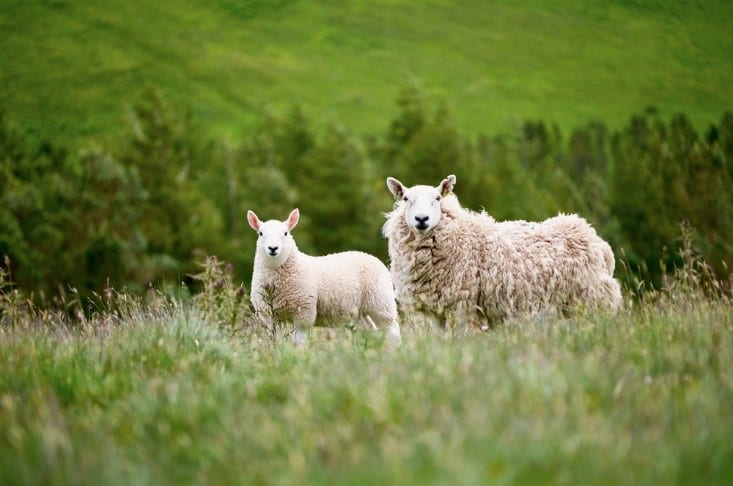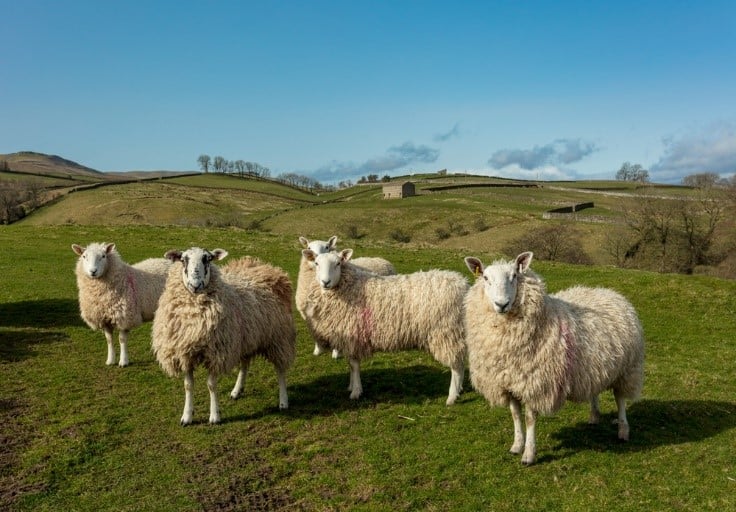There’s a hardy breed of white-faced sheep known for their tenacity, alertness, friendliness, and, best of all, their wool and meat production. The Cheviot sheep is a sheep breed like no other. Not only does it have a host of distinctive characteristics, but it also looks quite different from any other sheep breed.
The first thing you will notice about the North Country Cheviot sheep is that it has ears that stand out straight like a rabbit. This is unlike most other sheep breeds, which tend to have floppy ears. This hornless, clean-faced sheep breed is also alert and quite lively.
Mostly raised for their meat, wool, and extreme hardiness, there are several good reasons why sheep farmers might want to consider breeding and raising Cheviot sheep.
Here I explain the purpose for raising Cheviot sheep, care requirements, their temperament, history and origin, and lots more. I hope this helps you decide whether they will fit your livestock goals for your hobby farm.
Why Raise Cheviot Sheep?
There are several desirable traits that Cheviot breeders raise these white sheep. Here are a few notable ones.
Dual-purpose breed
As a farmer looking for the most efficient livestock, raising dual-purpose animals is often a good bet. Not only do the Cheviot sheep provide you with excellent, high-quality wool, but they also give you delicious lamb and meat. They aren’t typically raised for their milk production.
Excellent wool quality
As a long-wool breed, Cheviot wool has a distinctive helical crimp quality. This quality makes the wool extremely durable and resilient. It’s not the softest type of wool available. For that reason, Cheviot wool is often blended with other yarns to make it stronger and give it a longer-lasting quality.
Cheviot’s fleece is dense and also long-stapled, of 56-50s quality. It’s rather springy. These special properties also help reduce fleece rot and fly strike problems.
High quality meat
Like meat sheep breeds, Cheviots are known for their flavorful meat.
Extreme hardiness
This breed of sheep is one of the very few that can be raised almost anywhere. The breed is so tough that it can thrive in cold, wet winters and hot, dry summers. Of course, providing your sheep with the appropriate shelter during any harsh weather is important. However, this independent sheep can pretty much fend for itself otherwise.
Cheviot Sheep Breed on a Hobby Farm
Like all sheep, they are social animals. They do best in a flock of at least five sheep. Raising a flock helps protect them as well as provides socialization.
While they will get along with other animals you may be raising, such as alpacas and goats, they still need other sheep for companionship.
When raising Cheviot sheep, it’s important to provide land for grazing, proper shelter from weather and predators, water, and additional feed (hay, silage, or grain) to supplement their diets. They require a minimum of two sheep per acre. Plan for rotational grazing.
Like the life expectancy of most sheep, Cheviot sheep live for 10 – 12 years with proper care, nutrition, and protection from predators.
Temperament
Th breed is lively and energetic. As mentioned, one defining characteristic of the Cheviot sheep is its hardiness. This sheep can handle the bleak, windy and snowy conditions in Scotland and the United Kingdom and the extremely cold winters of Southern Australia with extreme ease.
Couple that with the fact that they are right at home in rough pastures as they can forage easily even when it’s bone dry or extremely cold. Furthermore, this breed of sheep is fast-maturing and not very picky when it comes to eating. They can survive even with minimal food.
While most sheep benefit more from attention, this is one breed that does fairly okay with less husbandry, according to the Ohio State University’s Department of Animal and Food Sciences.
Reproduction
Just as Cheviots are considered to be hardy sheep, they also have an admirable reputation as a prolific breeder. Cheviot ewes have easy lambing and often deliver twins. They have a good supply of milk to feed their lambs. In addition, they have excellent mothering instincts and have been known to protect their young against the harsh weather for maximum lamb survival.
Their estrous cycles are typical; the ewes come into heat on average every 15 to 20 days, while their breeding cycles last for about 36 hours.
Like most other sheep breeds, the Cheviot sheep have a gestation period of between 149 days and around 155, with most Cheviot ewes falling on the 152-day mark. Cheviot ewes have a lactation period between 150 to 240 days.
While they are mostly bred for their high-quality cheviot wool, they also produce good quality meat and lamb.

What Do Cheviot Sheep Look Like
When it comes to appearance, the Cheviot sheep are clean faced. They have a distinctive white face that’s bare and free of any wool. The sheep’s legs are also bare. They are generally hornless and have long, soft white wool.
Finally, they have black feet and black muzzles. The most distinctive feature, however, isn’t their Cheviot wool—which is medium—but their pricked ears.
The ears of the Cheviot sheep are unlike any other sheep breed. They stand erect like the ears of a rabbit. This gives the sheep its distinctive alert look. They are considered a small-to-medium sized sheep. Mature Cheviot ram will weigh between 160 – 200 pounds, while a mature Cheviot ewe will weigh around 130 – 160 pounds.
Some other white-faced sheep breeds are Texel sheep, Romney, Targhee, Merino, and Rambouillet sheep.
Cheviot Sheep Origin and History
Cheviot sheep are from a region known as the Cheviot Hills on the English and Scottish border. To say that these hills are a harsh environment to live in would be an understatement. Most of the hills are shaped like cones with extremely smooth and steep sides. The Cheviot sheep breed has lived on the upper part of these hills in Northumberland for about as long as anyone can remember.
These sheep are a crossbreed of several breeds. However, no one knows which breeds exactly. Some of these breeds may include:
- Lincolns
- Merinos
- Leicesters
- Southdowns
It has been rumored that there was even a local breed of goat, including the native sheep breed found in the region at the time, such as the Scottish blackface.
This sheep breed was officially shipped from Scotland into North America, specifically the US, in 1838. However, it has been rumored that it existed in the states long before that time.
Originally called the White Sheep or Long Sheep, the Cheviot sheep is an extremely hardy breed of sheep known for producing high-quality meat and wool in the cold countryside.
The Cheviot breed is also found in a host of other countries, including:
- Ireland
- Southwest England
- Australia
- New Zealand
- Wales
- Norway
The Cheviot sheep breed can be raised as a dual-purpose breed and has several variants, including the Western Hilly Cheviots, the North Country Cheviot, the Border Cheviot, the Brecknock Hill Cheviot, and South Country Cheviot sheep.
FAQs
Does Cheviot wool have any drawbacks?
While Cheviot wool is soft and white, it’s also crimped, meaning it springs back when you touch it. While this quality makes it extremely resilient and durable, the wool must be blended with other yarns to make it stronger.
Are there any issues plaguing the Cheviot sheep breed?
Unlike most sheep, Cheviot sheep have few issues plaguing the breed. Since they are extremely hardy sheep, they can survive on rough pasture and on meager feed. Their wool is also quite resistant to issues such as fleece rot and flystrike. That being said, very little negatively affects the animal’s health.
Is the Cheviot sheep breed right for my farm?
If you are looking for a sheep breed that will provide you with good quality wool, meat and milk and also mostly fend for itself, then yes, the Cheviot sheep breed could be the right breed.
Raising Cheviot Sheep
If you are looking to raise a dual-purpose sheep breed for wool and meat, having this tenacious hill breed on your farm can be advantageous economically. How much does a sheep cost
Thanks to the fact that it can survive anywhere, the Cheviot sheep is an excellent choice for any farmer looking for a breed that is relatively easy to raise. Like most all white-faced sheep breeds, Cheviot ewes have strong maternal instincts and produce high-quality wool.
Whether or not you plan to sell their wool, you will need to shear them so they stay cool in the warm months. Learning how to shear a sheep is important or you can hire someone to do it.
Sheep are not difficult to raise; however, they require a higher level of management than beef cattle. If you are new to raising sheep, and factoring in the pasture available, starting small with 20 – 50 ewes is recommended.
Over time, you can increase your flock size. How many sheep per acre you can raise depends on the quality of pasture and if there is year-round forage, etc.
Learn more about raising sheep on your homestead:
- Merino sheep ~ Docile with high-quality wool
- Lamb vs sheep
- Icelandic sheep ~ Ideal Provider of Meat, Milk, Wool and More for Your Homestead
- Columbia sheep
- Sheep names

